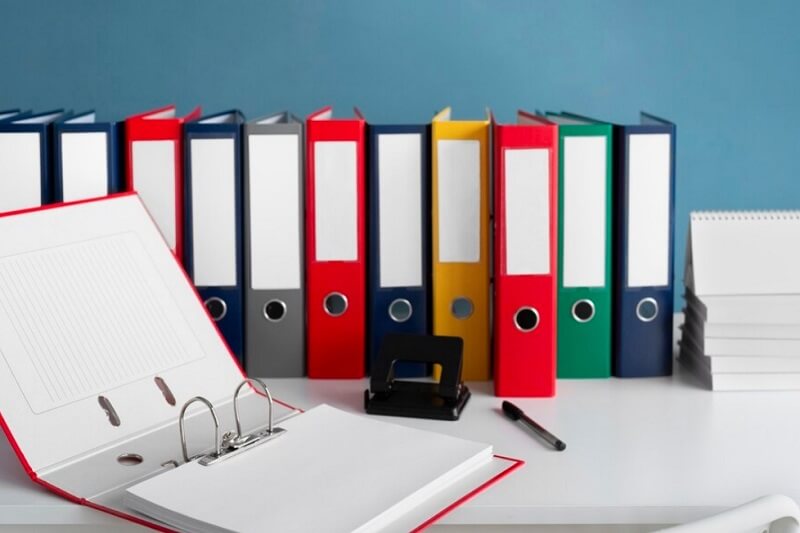Keeping an office organized, whether at home or in a dedicated building, is no simple task. When your business requires you to have hard copies of information on hand, it becomes even more complicated to keep your information organized and secure.
So, are you doomed to searching stacks upon stacks of papers for that one piece of information that you know you need, but can’t find? Not with file folders, you’re not!
Of course, it’s all well and good to say that using file folders will fix your organizational challenges. It’s quite another to figure out how to use them well. Our guide will show you how to organize papers using file folders, the types of file folders you can get, and where to buy them.
Understanding the Types of File Folders
When you look at the name, it’s easy to think that there aren’t that many types of file folders. However, as anyone who’s ever gone shopping for school supplies or report bindings knows, you can get lost on an aisle full of nothing but folders.
So, what types of file folders are there? Below, we go over some of the most commonly used varieties.
Fastener Folders
Fastener folders are a unique beast. They look like your standard project folder but lack any pockets. Instead, they use adhesive or prongs to adhere the documents within to the inside of them.
They don’t usually have any sort of tab on them. So, if you want to use fastener folders for your filing system, you need to make sure each folder gets clearly labeled and color-coded. Otherwise, crucial documents could get lost in the shuffle.
Hanging File Folders
When most people think of organizing office files, this is the type of folder that they imagine. Hanging file folders, as the name suggests, hang on railings within a drawer or filing cabinet, where they can get pulled past at a moment’s notice.
Due to their ease of adjustment, they became the main folders used in offices. However, low-quality hanging folders can crumble beneath the weight of the paper in them, and the tabs on these tend to be quite small. This can make it difficult to track a specific tab when the cabinet is stuffed full of paper files.
Classification Folders
Classification folders function sort of like a mix between a fastener folder and a slim three-ring binder. These folders have tab dividers on the inside of them, so they’re tailor-made for holding multiple documents about the same person or event.
This makes them perfect for employee rosters, criminal dossiers, or even legal case documents. (However, if you use them for that purpose, you might want to invest in some quality exhibit tabs like those from Legal Supply.)
Project Folders
Remember those folders you used as a kid? The ones with pockets that you’d use for homework or simple projects, usually with one side labeled per subject? That’s what project folders are.
These handy file folders can offer some extra storage space for those in desperate need of more slots for relevant documents. You can get them in paper or plastic, with or without holes punched in them.
Standard File Folders with Tabs
Last but not least, we have the standard manilla folder with a tab that most people think of when they picture a file folder. These folders can come in a wide variety of bright or standard colors, with or without reinforced tabs.
The tabs, themselves, can determine how they get used in a filing system. Typically, you’ll get sets of folders with 1/3, 1/5, or 1/8 cut tabs. As you might expect, the cut determines how many possible tab positions rest on the folder.
How to Organize Papers and Office Files Effectively
Once you’ve stocked up on file folders, then it’s time for the hard part. What’s the hard part, you may wonder? Oh, keeping all of these papers organized and filed away.
Even keeping a clean desk can prove difficult for those of us working from home. No matter how many helpful how-tos we may read. So, how are we supposed to organize office files effectively?
The most common methods and tips include:
Alphabetical Order
If you’re working with an employee dossier or anything with a lot of names and subjects, then alphabetical order should be your go-to filing system.
If you choose this system with a series of names, make sure your filing rules remain consistent. For example, if you’re alphabetizing by the first name, stick to that system throughout. Don’t randomly swap to alphabetizing by surname instead.
And remember, if the letters match, keep going until you reach something different. Then, organize by that. For instance, in a standard alphabetical order by surname system, you’d have Karen Smith before Katie Smith.
Chronological Order
If you’re trying to organize transactions, invoices, or completed files, then chronological order should be your filing system of choice. In large retail stores, for instance, you’ll see the inventory printouts and delivery slips placed in order by the dates received. As long as you know the date, you can find the file or invoice that you need.
Again, consistency is key in using this system. Make sure everything that happened within certain months slots into that month’s folder. If you’re organizing by day, keep the files together by day. If by month, then by month. So on, and so forth.
Filing systems that use chronological order often require the most cleaning and maintenance as time goes on. Otherwise, you’re going to run out of room to expand your file cabinet into the next year.
File by Subject and Association
This filing method is an odd duck, as it doesn’t have a set order to follow. At least, not on the outside. As such, for those who think linearly, a subject and association system is a recipe for losing critical information.
However, if you tend to think in webs and pattern recognition, subject and association filing might be useful for you. Think about a student’s three-ring binder, with separate tabs for each subject. That’s an example of subject and association filing.

Plus, using this method doesn’t preclude you from using other filing systems inside the sections. Returning to the student’s binder, for example, those notes should be in chronological order based on when the student wrote them.
Use Consistent Colors for Color-Coding
Whether you use color-coding as your entire system, or a means to subdivide a section, make sure that you remain consistent throughout. For instance, if you use the color red for clients, invoices, or other documents that need urgent attention, don’t leave completed documents in those folders.
Or, if you use yellow folders or tabs to indicate a specific subject like Science or Math, don’t also use a yellow tab for an English section. Consistency is key to keeping school and office files organized.
Make Sure you Have Enough Space
You can’t find new places to store paper files indefinitely. You’re going to need somewhere to put all of these folders. That means having the desk, shelf, or cabinet real estate to stow your documents.
Speaking of storage…
Where to Store File Folders
Whether you need to access file folders on a regular basis or need somewhere to put completed tasks, you need somewhere to store your file folders. Some possible locations include:
File Cabinets
File cabinets are by far the most popular and most expensive place to store your important documents. These metal cabinets can weigh over 200lbs when full and can come with locks. This makes it the best choice if you have loads of documents that you need to keep away from prying eyes.
Binders
If the security of the documents isn’t a concern, or you don’t want to throw everything into hanging file folders, you can always organize your office files into a 3-ring binder. Or multiple binders, if you need to divide the documents further.
This will require that you buy folders with holes punched in them so that you can store them and view the documents at will, as well as tab dividers to keep everything labeled and clear.
Document Boxes
Don’t want the hassle of a file cabinet or a binder? You can always throw your file folders into document boxes. If you go this route, make sure that you either have a distinctive color-coding system or clear labels on the front of each folder. Otherwise, you will lose things in the shuffle.
Paper Organizers
If you tend to have a lot of papers and file folders on your desk, or a busy inbox and outbox, tiered paper organizers could be your best friend. Not only do they give you more vertical real estate for your desk, but you can stack them as high as you need to, depending on how many divisions you have in your office files.
Where to Buy File Folders
Now that we’ve discussed what file folders are, some common filing systems, and where you can store them, let’s take a moment to discuss where you can buy file folders. You can buy these useful office supplies from a wide variety of places, including but not limited to:
Office Supply Stores
Of course, if you go to an office supply retailer, you can find every possible type of file folder you need. Paper, plastic, pocketed, pronged, what have you. If you speak with the employees there, they may even be able to offer you some advice on what filing system will work best for your needs.
Big Box Stores
If time and price are a concern, most big box stores sell a variety of file folders. You might not get the same variety and quality that you get at an office supply retailer, but if you’re on a shoestring budget and in a hurry, these stores can give you the tools you need to get started. Just don’t expect much help with your organizing project from the employees.
Online Retailers
It’s impossible to talk about ordering supplies for office files without discussing online retailers. Ordering online saves you the hassle of having to drive or walk to a store, but can lead to complications if you receive the wrong type of file folders. Most major online sellers have generous return policies, but if the paper products got damaged in any way, even in transit, then you could be out of luck.
Dedicated Manufacturers
Last but not least, if your file folder needs are too specific for any basic retailer to cover, you might need to place your order through a dedicated manufacturer. These printing companies exist, and can give you pre-printed, pre-cut folders in the exact size, color, and configuration that you need.
The one downside to services like this is that they cost more than picking up pre-made folders. However, there is no better way to make your business feel like it’s a professional organization than to have custom file folders.
Let’s Review Everything you Should Know About File Folders
We covered a lot of information above, so let’s take a moment to review everything you need to know about file folders.
There are many different types of folders, from hanging to pronged, that you can use for any organizational need. You can then organize these file folders in whatever way suits your business or home the best in a file cabinet, document box, or binder. You can pick up these handy supplies, and many more tools to help you organize papers, either in physical stores or online from specialists.

